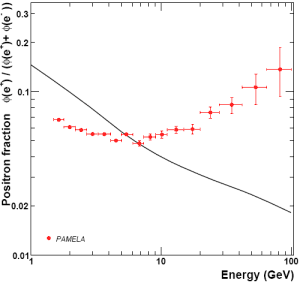In recent weeks, there has been a lot of discussion in the physics community about a curious observation: an abundance of energetic positrons observed by a satellite named PAMELA. According to some people, this unexpected abundance of positrons is likely caused by annihilation of massive dark matter particles, constituting “smoking gun” evidence that dark matter really exists.
Of course it is possible that this abundance is due to some conventional astrophysics, such as pulsars doing this or that. This is a subject of on-going dispute.
One thing I do not see discussed is that the anticipated behavior is apparently based on a model developed several years ago that uses as many as eleven adjustable parameters yet nevertheless, does not produce a spectacularly good fit of even the low energy data. I wonder if I am missing something.
